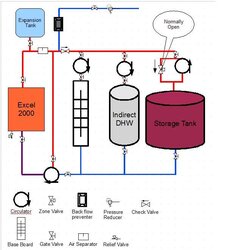hi All,
Thanks for all the good information on this site and some of your own personal sites, it's very helpful.
If you would please critique my proposed system design based on the attached picture. If anyone is interested I drew it using the free Open Office Draw app, I'm happy to share the original file if anyone wants it. Nofossil, I based the designs off of your various diagrams, I hope you don't mind. Thank you.
After you view the diagram I have a couple questions. With the proposed layout will the storage tank act as a over heat loop if the power goes out? I believe it will as long as water can continue to flow through return circulator on the boiler.
Another question.. Are the plate type HXs mounted externally to storage? And are they being pumped the "dead" water from the storage tank? I am probably going to use a prebuilt tank with copper HX but the plate HXs would probably be the way I go if I end up building a tank.
thanks, Aaron
Thanks for all the good information on this site and some of your own personal sites, it's very helpful.
If you would please critique my proposed system design based on the attached picture. If anyone is interested I drew it using the free Open Office Draw app, I'm happy to share the original file if anyone wants it. Nofossil, I based the designs off of your various diagrams, I hope you don't mind. Thank you.
After you view the diagram I have a couple questions. With the proposed layout will the storage tank act as a over heat loop if the power goes out? I believe it will as long as water can continue to flow through return circulator on the boiler.
Another question.. Are the plate type HXs mounted externally to storage? And are they being pumped the "dead" water from the storage tank? I am probably going to use a prebuilt tank with copper HX but the plate HXs would probably be the way I go if I end up building a tank.
thanks, Aaron


